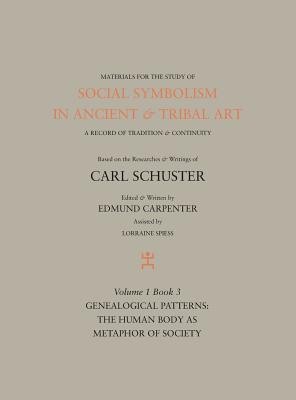
- We will send in 10–14 business days.
- Author: Edmund Carpenter
- Publisher: Rock Foundations Press
- Year: 2015
- Pages: 240
- ISBN-10: 1943982023
- ISBN-13: 9781943982028
- Format: 21.6 x 27.9 x 2.1 cm, hardcover
- Language: English
- SAVE -10% with code: EXTRA
Reviews
Description
3. Vol. 1, Book 3 - Genealogical Patterns: The Human Body as Metaphor of Society
Book three, Genealogical Patterns: The Human Body as Metaphor of Society, presents how genealogical patterns are drawn in clusters with a single head at the top to represent an entire tribe, and the human body is conceived as a metaphor for the society. Various examples of creation myths where the body of the first ancestor or god is quartered to create the tribe are raised, and a connection is made between representations of the society and "heavenly ladders." Carpenter discusses the close correlation between body painting, dancing costumes, house posts and memorial columns. What distinguishes genealogical pattens from representations of human figures are continuous limbs, shared by multiple figures. Myths of birth from limbs are related. The human body is used as a metaphor for society and kinship, both visually and conceptually. Dismembering and sacrificing rituals are discussed in the last chapter. Legitimization of familial lines through the father is enacted by placing the child on the father's knee.
EXTRA 10 % discount with code: EXTRA
The promotion ends in 20d.23:40:55
The discount code is valid when purchasing from 10 €. Discounts do not stack.
- Author: Edmund Carpenter
- Publisher: Rock Foundations Press
- Year: 2015
- Pages: 240
- ISBN-10: 1943982023
- ISBN-13: 9781943982028
- Format: 21.6 x 27.9 x 2.1 cm, hardcover
- Language: English English
3. Vol. 1, Book 3 - Genealogical Patterns: The Human Body as Metaphor of Society
Book three, Genealogical Patterns: The Human Body as Metaphor of Society, presents how genealogical patterns are drawn in clusters with a single head at the top to represent an entire tribe, and the human body is conceived as a metaphor for the society. Various examples of creation myths where the body of the first ancestor or god is quartered to create the tribe are raised, and a connection is made between representations of the society and "heavenly ladders." Carpenter discusses the close correlation between body painting, dancing costumes, house posts and memorial columns. What distinguishes genealogical pattens from representations of human figures are continuous limbs, shared by multiple figures. Myths of birth from limbs are related. The human body is used as a metaphor for society and kinship, both visually and conceptually. Dismembering and sacrificing rituals are discussed in the last chapter. Legitimization of familial lines through the father is enacted by placing the child on the father's knee.


Reviews